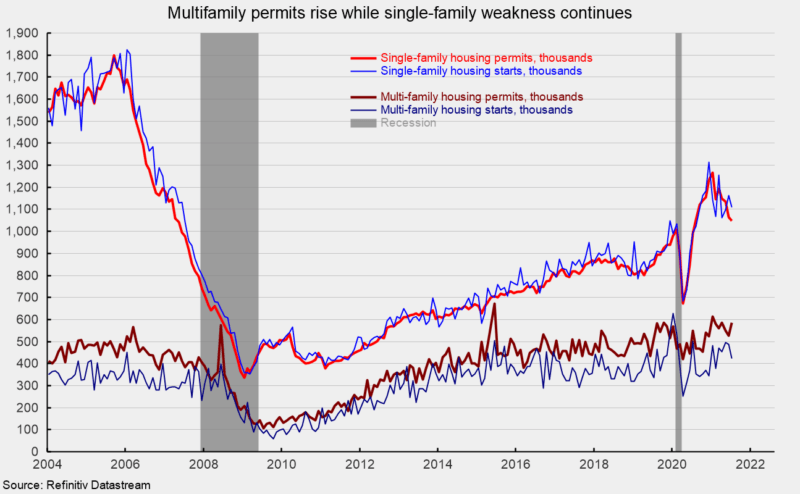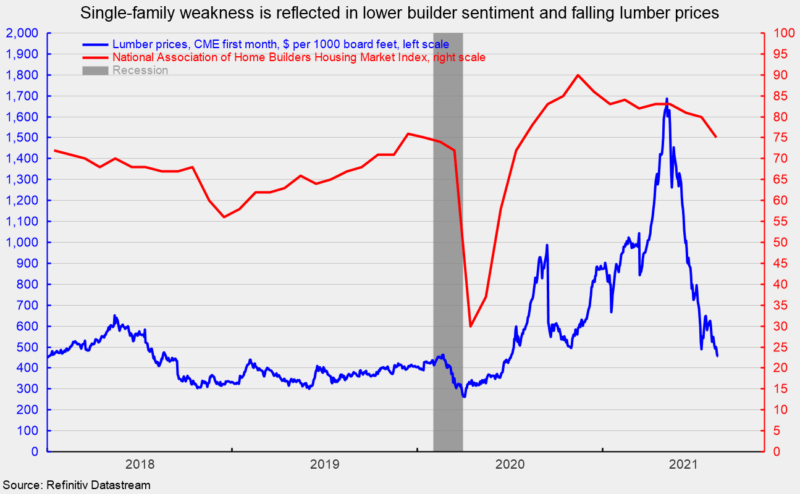Struggles Continue for Single-Family Housing
Total housing starts fell to a 1.534 million annual rate in July from a 1.650 million pace in June, a 7.0 percent decrease. From a year ago, total starts are up 2.5 percent. However, total housing permits rose 2.6 percent to 1.635 million in July from 1.594 million in June. Total permits are 6.0 percent above the July 2020 level. The gain in permits was driven completely by a jump in permits for multifamily housing.
The dominant single-family segment saw starts drop 4.5 percent for the month to a rate of 1.111 million but are still up 11.7 percent from a year ago. Single-family permits were down 1.7 percent at 1.048 million. Single-family starts and permits continue to trend lower from peaks around the start of the year (see first chart).
Starts of multifamily structures with five or more units fell 13.6 percent to 412,000 and are off 16.3 percent over the past year but starts for the two- to four-family-unit segment gained 10.0 percent to 11,000. Combined, multifamily starts were down 13.1 percent to 423,000 in July (see first chart).
Multifamily permits for the 5-or-more group jumped 11.1 percent to 532,000 while permits for the two-to-four-unit category rose 12.2 percent to 55,000. Combined, multifamily permits were 587,000, up 11.2 percent for the month (see first chart).
Single-family home construction had been one of the strongest parts of the economy last year and excluding the plunge in activity during the government-enforced lockdowns in early 2020, single-family housing activity has been on an upswing for most of the last decade, recovering from the housing bubble and collapse of the late 2000s (see first chart). The post-lockdown recovery has been supported by a surge in demand as consumers sought less dense housing. However, since December, single-family activity has been trending lower. It may be that some of the rush to less dense housing that drove the single-family surge in activity in the second half of 2020 is starting to ease as the economy opens, more people get vaccinated, and workers return to offices, though the emergence of the Delta variant may once again drive shifts in housing demand. Furthermore, surging home prices have pushed some buyers out of the market.
The surge in housing demand that sent lumber prices soaring has also reversed course in recent months as sales and construction show signs of cooling. Lumber prices peaked at around $1,686 per 1,000 board feet and are currently around $458, a drop of more than 70 percent (see second chart).
Furthermore, the National Association of Home Builders’ Housing Market Index, a measure of homebuilder sentiment, fell again in August, to 75 from 80 in July and a peak of 90 in November 2020 (see second chart). Overall sentiment remains relatively high but elevated materials costs, supply shortages, and rising home prices that are forcing some buyers out of the market are all weighing on builder sentiment.
Two of the three components of the Housing Market Index fell in August. The current single-family sales index fell to 81 from 86 in the prior month and the traffic of prospective buyers index was off five points to 60 while the expected single-family sales index remained unchanged at 81 for August.
Housing may yet find some support in 2021 but the combination of softening demand and rapidly rising home prices will continue to be a headwind. For the homebuilders, rising materials costs are hurting margins or forcing price increases that hurt demand while labor difficulties and materials shortages restrain supply.







